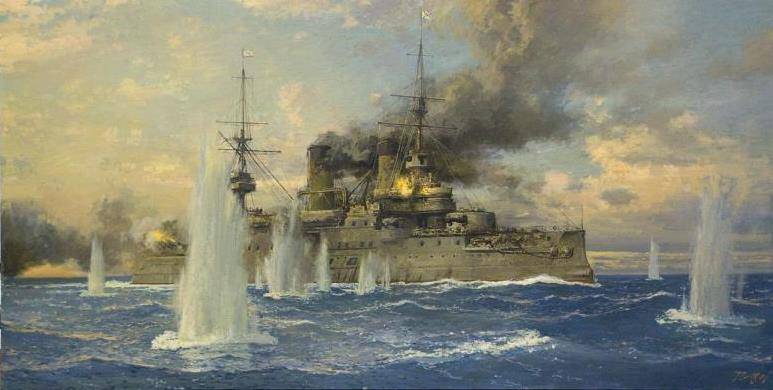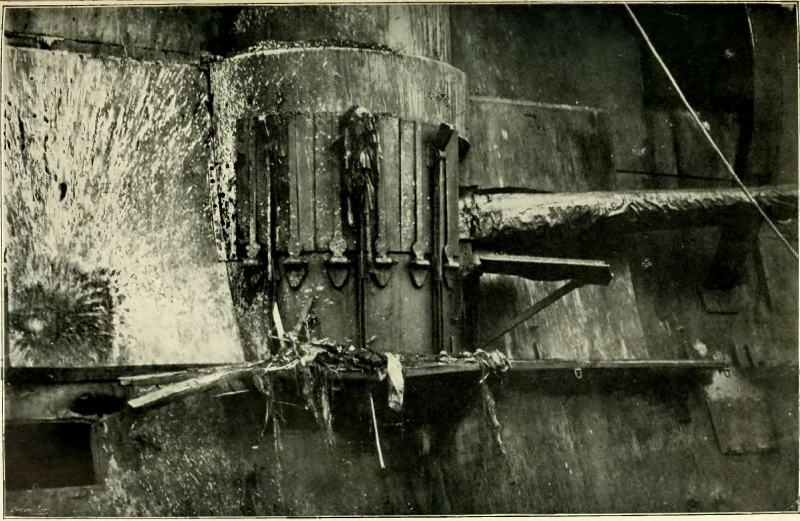Lessons from naval battles of the Russo-Japanese War. View from France. Artillery

Artillery
The effectiveness of large-caliber artillery in the battles that took place between Russian and Japanese ships is confirmed by all documents. But not everyone in France believed that it was necessary to get rid of medium-caliber guns. According to some officers, it was the shells of this artillery that seriously damaged the Russian battleships in the Tsushima battle.
The Russians opened fire from about 8 meters, the Japanese began to respond only from 000 meters and closed to a distance of 6 meters. Reports note that the maximum effect produced by artillery was achieved at a distance of 000–3 meters.
About the Battle of Tsushima, Admiral Togo wrote:
... the fire became fully effective only when the squadrons came close enough "...
Russian sources also report that two fleet approached at a distance of up to 3 meters.
This is not surprising, at a distance of 3 meters, shooting will certainly be more accurate than at a distance of 000, 6 and 000 meters.
At a distance of 3 meters, the 000-mm gun is formidable weapon. Its projectiles, exploding against the side or deck of the ship, inflict huge damage, injuring or killing with their fragments, and also have a very strong suffocating effect on all personnel in the immediate vicinity of the explosion site.
If the projectile is armor-piercing, it can penetrate an armor plate with a thickness equal to its diameter, that is, the thickest armor that existed at that time.

Part of a Japanese large-caliber projectile that hit the battleship Tsesarevich.
It is quite obvious that an ironclad armed with 305 mm guns and reinforced in all its parts with armor thick enough to protect it from the 305 mm projectiles themselves, would be a formidable weapon of war. But this is not feasible.
Still less should one dream of arming an ordinary battleship with only 305 mm guns, because of the small number of these guns that she could carry, considering that the weight of defensive towers must be added to the weight of the guns, their mounts and projectiles. It will be necessary to design a ship with an increased displacement, and this will require the restructuring of not only the docks, but also the entire port equipment.
At present, the rate of fire at firing ranges is 30 seconds for 305 mm, 240 mm and 194 mm guns. For a gun with a caliber of 274,4 mm, 34 seconds are required. At the same time, 164,7-mm guns fire 3-4 rounds per minute. Therefore, the rate of fire and the number of guns are of great importance for the armament of an armadillo.
The medium artillery of the Japanese was able, due to their superior numbers, to inflict heavy damage on the Russian ships they fired on, while the less trained Russian gunners achieved a small number of hits that did not cause serious damage to the Japanese battleships. While Admiral H. Togo had thrown the Russian squadron into disarray with his medium artillery, he approached and used his large-caliber artillery in such conditions that he could not be afraid of Russian guns.
Medium artillery, due to the large number of guns, is an excellent means of destroying all secondary equipment, chimneys, masts, command and steering bridges, small-caliber artillery, the destruction of which makes it very difficult to protect the ship from destroyers, causing fires. Its effect is proportional to the number of guns and rate of fire.
A 305 mm projectile hitting an armadillo undoubtedly produces a very strong effect, even if it does not penetrate the hull, but this effect is local in nature, because the gun is fired slowly.
Everything else is the effect produced by the shells that the medium artillery continuously rains down on the ship, on all its parts at the same time.
The change in design and the replacement of 18 164,7-mm guns on battleships of the République type by 10 194-mm guns, according to this group of officers, only led to a weakening of firepower.
The battleship République could fire 1 kilograms of iron and explosives per minute in a broadside salvo from medium-caliber artillery, while the 404 5-mm guns of the battleship Démocratie could fire only 194 kilograms, but inflict much more damage than 860-mm guns .
These conclusions fully confirmed the opinion of that part of the naval and artillery officers who considered it necessary to keep this artillery on the new battleships.
164,7 mm naval guns
In France, 5 models of 164,7 mm guns were developed, during these works the length of the charging chamber increased from 950 mm to 1 mm. The weight of the charge has grown from 300 kilograms to 13,1–18,3 kilograms. These changes resulted in increased strength of gun mounts, replacement of recoil devices, and special attention was paid to strengthening the barrel strength.
According to the French, the barrels used for naval guns were superior to those produced in England and used in the Japanese fleet. Based on available reports, gun barrels were often damaged by firing, unable to withstand the loads.

Rupture of the barrel of a 6-inch English gun.
In models 1887, 1891, 1893-1896. a charge in a brass sleeve was used, in models 1893–1896 M a charge consisting of a silk cap and a brass sleeve was used, later a charge consisting of two silk caps was used.
But this forced changes in the design of the supply elevators, as well as in the internal layout of the artillery cellars. In connection with the increase in the charge, the strength of the shells was increased. If in steel shells this happened due to a change in the composition of steel, then in cast iron shells, the wall thickness had to be increased, which led to a decrease in the amount of explosive in the shell.
Commission request
The commission turned to the Naval Artillery Directorate with a request for clarification on the proposal to use 164,7 mm guns in new battleship projects.
Received a response very quickly:
cemented armor

If we take as the limit of the effective penetration distance the one at which the projectile is still capable of penetrating a thickness of cemented armor equal to its caliber at a fall of 30 degrees, then it is clear that the 164,7 mm projectile is effective from this point of view only up to 3 meters.
Thus, this caliber is no longer sufficient in combat. It should be added that at present, from the guns of the 1893-1896 model. shooting reaches no more than three rounds per minute, with a two-section charge. For the 1902 model discussed above, the speed is 950 m/s, the rate of fire is reduced to two shots per minute. These shells will not have a significant effect on the armadillo armor.
The projectile, weighing 52 kilograms, can be used in the armament of cruisers or mail and passenger high-speed steamers in war. Therefore, it is advisable to use a smaller caliber for this projectile. Then it is possible to achieve an increase in the rate of fire, a projectile weighing 52 kilograms is relatively light for a 164,7 mm gun. A suitable caliber for a 52 kg projectile would be a 150–155 mm gun.
So, in any case, the 164,7 mm caliber should be abandoned, the secondary artillery on the battleships will be 194 mm or 240 mm, which is effective at distances from 6 to 000 meters against the armor of the upper belt and the extremities of similar battleships of other countries " .

A high-explosive shell hit the armor of a casemate of a 6-inch gun of the armored cruiser Gromoboy.
After this response, discussions regarding the installation of 164,7 mm guns on battleships were discontinued.
Продолжение следует ...
Information